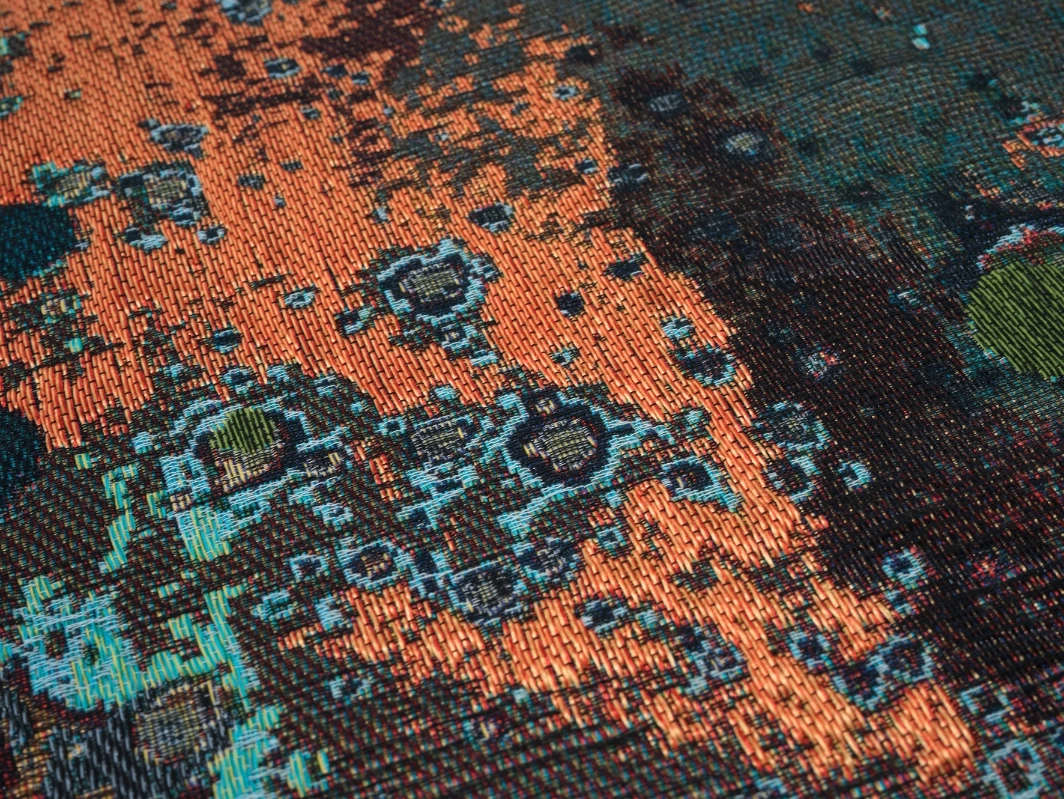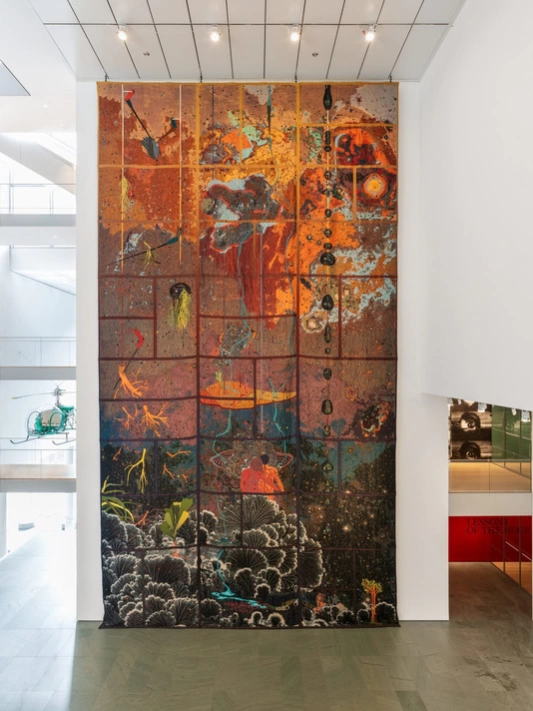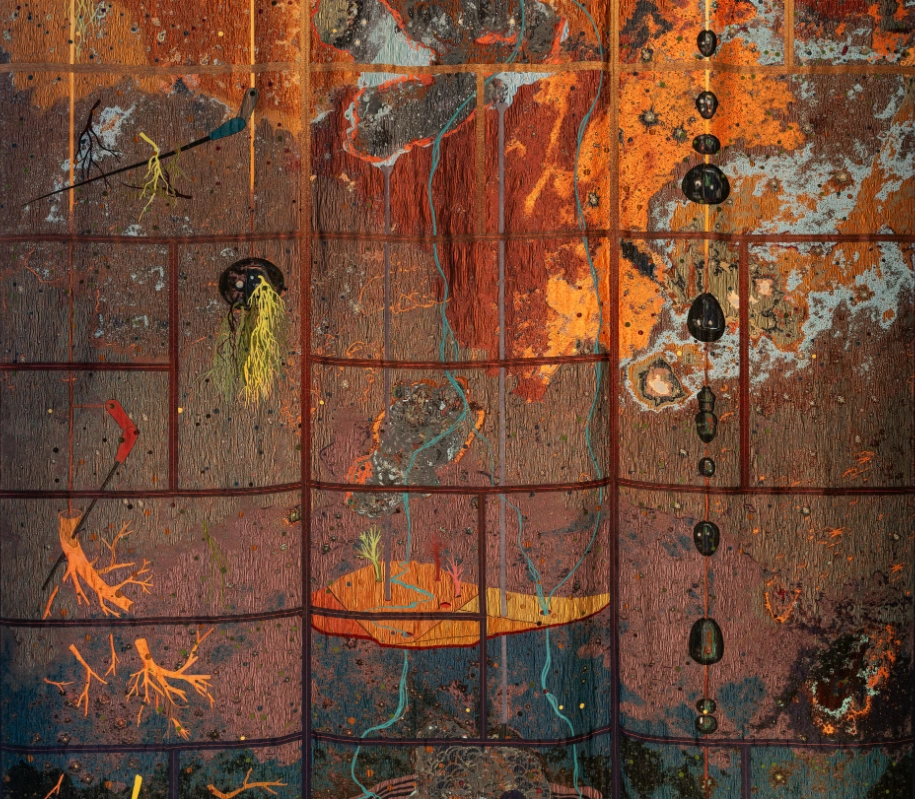Nkanga fuses tapestry, sculpture, sound, and poetry to explore the rhythms of life, weaving together galaxies, ecosystems, and emotions.
On the occasion of Otobong Nkanga’s monumental new MoMA commission Cadence, created specifically for the Museum’s Marron Family Atrium, we sat down with the artist to discuss her complex installation. A multipaneled tapestry, sculptures, sound works, and poems fill the vast space, suggesting sprawling ecosystems and galaxies, while confronting the beauty and degradation of the natural world.
Can you tell us about all of the components of Cadence?
Once I’d visited MoMA, I was interested in creating a tapestry work for the highest wall in the Atrium, which would allow for a way of looking into the world from a different perspective. I wanted to create the notion of falling: a fall of things, a certain shift, a certain rhythm. The tapestry opens up to a more three-dimensional space, with sculptural pieces made of clay, smoked raku, and glass hanging from ropes and sitting on anthracite rocks, and a sound piece integrated in the sculpture that relates to the notion of tear drops, which is another kind of fall. And there will also be performances that activate all these elements.
I wanted to make something that explores different rhythms of life. You might also feel that it’s a world that is beyond this one, like the universe somehow. It’s a mix of different worlds—from the underworld and the mining of minerals, to the surface and the soil, to the atmosphere and the heat of the sun, into outer space—all collapsing together in one place. That’s what creates the cadence of life. That’s what creates, actually, a world, because you cannot separate what is happening in the universe from what is happening underneath the soil in the core of the earth.
Where did the vision for this installation come from? Did the space inspire you, or did you already know you wanted to create something like this?
I might not always know what I want to make, but I need to know that there is a possibility of my emotion matching with what a particular space is offering. It could be the light, it could be the way the sound registers in that space, it could just be the way people navigate the space. One of the things here at MoMA is the scale. And not just the scale of the Atrium, but the scale of people moving through, the scale of sound, the scale of the light and the way it also moves throughout the day. Another aspect that I was very curious about is how the sculptural works could find form within this huge space.
How are you thinking of the audience in relation to this commission? Are they meant to move through the space in a particular way?
There are different aspects of considering how the public might move through the Atrium, but of course, as human beings we’re very unpredictable! At least one thing is certain: the tapestry is about 60 feet high, so it covers the whole wall. People will want to stand back and look at the tapestry, or try to come close and look at it. People will be walking around and maybe stopped in their tracks wondering about the particular materials of the sculptures, or they might be startled by the sound works. I hope they might sit withCadencefor a while.

Detail of a textile in progress for ‘Otobong Nkanga: Cadence’, 2024
What was the process of creating this monumental tapestry?
I’ve been working with tapestry since 2010. Every year I make a tapestry, and I’m always developing different ways of working, thinking of the yarns, thinking of the various warps and wefts of weaving. With mechanical weaving, you can work in infinite ways. For this tapestry, there are more than 200 colors involved. We don’t see them all, but they are there. And I worked with 12 kinds of yarn with different transparencies and tensions and sheen. Over the years I’ve come to understand that I can actually build layers into my weaving. This tapestry has four; some of the stories are hidden behind a layer. You will not see them all. So it’s really thinking of what you reveal and what you don’t see. You need time to be able to see certain things, while others are really thrown in front of you, and you might think at first that’s the story, but then something else emerges.
Could you explain a little more about the weaving process for people who may not be familiar?
You are working with the warp, you are working with threads that are already almost a structure, like a skeleton, and then you’re putting the flesh in between. In its most simple form, you take a thread and you take another thread perpendicular, and then you have the other one crossing over it. Through those strings, you pull another string. A basket or a mat is one of the earliest forms of weaving. Every single culture weaves, and we’re always weaving even if we don’t realize it. Airbags in cars, NASA materials, they’re woven. In our computer chips, you have woven materials. And even binary codes are a weaving technique because it’s 1 0 0 1, then you can do 0 1 1 0.
Machines have always been informed by our hand gestures, so even in mines, the way the machines enter, explore, extract minerals, is based on the way our hands work. Automated machines learn from human gestures. The only thing that separates machine and hand weaving is speed and productivity. A world that builds with capital and speed and accelerated labor needs to create machines that go faster, that calculate faster, and we can add AI to that, which then comes in to calculate even faster. The kinds of weave, the complexity of the weaves are different, but the method of making is ultimately the same.

Detail of ‘Otobong Nkanga: Cadence’ at MoMA, 2024
What was the process of collaborating with the TextielLab in Tilburg, the Netherlands?
The TextielMuseum in Tilburg is a fascinating space. If we look at the city’s history, Tilburg has always been a place for fabric making. There were lots of industries in the 19th century involving cloth production. All those industries are now gone, so this is one of the very few spaces that shows us the history of fabric making and tapestry making, jacquard looms, and different kinds of productions over time. The museum created a lab meant for artists, architects, and all kinds of creative people to be able to make their prototypes and think through experimentation. It has been so amazing to be able to develop and think through tapestry with them since 2010.
But before that, as a teenager in Nigeria with my mom, I worked a lot with batik making and dyeing. That’s where I learned about synthetic and organic yarns, what happens when you dye them, how they feel. You go to the market, you say, oh, that’s silk, this is satin, this is polyester, this is organza, this is taffeta. So my interest in relation to material, in relation to yarns, in relation to clothing textures, what is breathable, what is not, was there from a very young age.

Detail of ‘Otobong Nkanga: Cadence’ at MoMA, 2024
What has making a tapestry on such a monumental scale been like?
It’s been daunting, because I didn’t know how to draw the cartoon at this scale and I had a month and a half to put it together! I made 40 files with 40 different drawings, because each time I came and worked at the machine, I would be like, oh no, that’s not working. Sometimes I would draw something, like a plant, and when I wove it, it was too tiny, so I had to go back again and scale up the drawing. I also had to find a way to have a single drawing file for the whole tapestry, because if you’re doing segments, since it’s quite heavy, you might lose the part of the connecting lines between the drawings. This required a lot of computing power so that I could continue to draw without the file crashing.
When you are giving information to the computer, you have to be very clear about colors. Even if you’re scanning a simple black drawing, you have purple, green, yellows, all kinds of colors in it, so you have to come back and clean all that up and make sure you just get a black line, and that’s it. Clarifying and preparing the digital cartoon takes a lot of time. And then while weaving, you might need to adjust the drawing constantly.
It was merciless. It was intense. But I learned a lot. I already know where I’m going for my next tapestry. Each tapestry opens up possibilities, so each one is actually a growth from the last one. In my dreams, I’ve made huge tapestries. In the real world, this is the biggest tapestry I’ve ever made. I’m not so interested in size, but what the work is doing. But in my dreams, the tapestries are even bigger. I fly on them.

Detail of ‘Otobong Nkanga: Cadence’ at MoMA, 2024
How does the tapestry connect to the sculptural, sound, and text elements in this installation?
I was thinking of tears and how you translate an emotional state. How do you give form to anger? How do you give form to happiness in an artwork without just stating, “I’m happy”? I was fascinated by the possibility of rendering visible an emotional state: how when you cry, you are expelling a form out of the body that relates to an emotion. If I take this teardrop and try to let it drop slowly and calculate the kinds of movement it makes, you will see that the teardrop is making different kinds of forms until it explodes on the floor or on the table. That movement in slow motion creates the form of the sculptural work.
Our teardrops contain minerals. We think of them as transparent, but they are filled with so many emotions. That’s why one of the sculptural works is glass and shifts into a gradient of color. And then I was thinking, what if this teardrop had a voice? What would it say? How would it say it? So there are teardrops that are a mixture of happiness and sadness, anger, melancholy. The sound work explores the fragmentation of a tear and the emotion that goes with it. It’s not necessarily something that is negative, but it is something that looks at the range of what a tear could be and the emotions that come with that. There are also tablets where I have poems that have been pressed into the clay piece and fired. Some of them talk about tears, some talk about lingering dreams, some talk about different relationships to physical and emotional connections.
In such a short time, so many people have passed away around the world due to COVID-19, due to so many situations, but we rarely hear how people are dealing with this. Sometimes when you’re walking in the street and you see someone really cry, you can feel that they are trying to contain their weeping. There’s a kind of shame to crying; as a society we censor it. There’s a lot of silence. We all seem to continue working. People are the silent tears that have turned to solid rocks in quiet homes. And I was just thinking of what that meant to be able to express that emotional space of just one teardrop, but in a very sculptural way. Throughout Cadence, I’m interested in rendering what is normally invisible visible.
This is my first exhibition here in New York. I’m excited. I will be discovering with the public how this piece works. When you have a commission, it’s worth taking some steps to explore things you’re not sure of. That’s one of the things that I feel grateful about, to have the possibility in a place like this to dream. And then, let’s see.
Otobong Nkganga: Cadence is on view at MoMA through June 8, 2025.
Source: MoMA







